Awash with majestic scenic views, a diverse array of flora and fauna, and steeped in rich history, Rocky Mountain National Park invites outdoor enthusiasts and casual day trippers alike to its vast, unspoiled wilderness. Our comprehensive guide delves into all the critical aspects of exploring this iconic destination, from its top-rated trails to essential tips for safe and enjoyable hiking experiences. We will also unravel the park’s seasonal transformations and shed light on its fascinating history and cultural legacy. By equipping yourself with this knowledge, your journey through the dramatic landscapes of Rocky Mountain National Park can become not just a thrilling adventure, but also an educational odyssey.
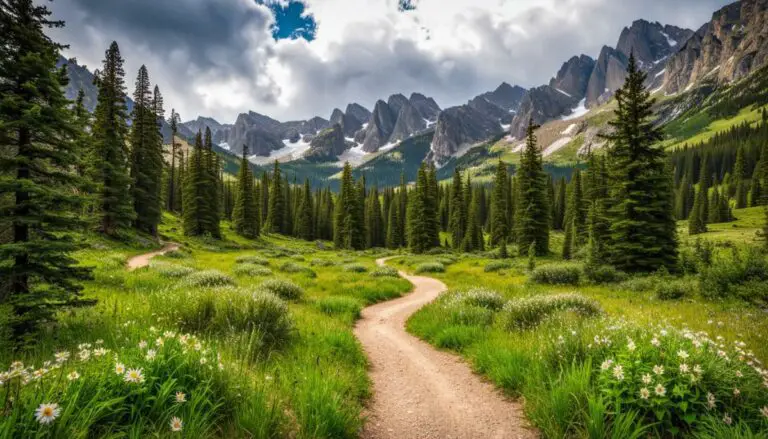
Best Hiking Trails in Rocky Mountain National Park
Emerald Lake Trail
Located near Estes Park, the Emerald Lake Trail offers stunning views and landscapes with a relatively easy climb. The out and back trail is 3.2 miles in total with an elevation gain of 708 feet. The trail takes you through Dream Lake and Nymph Lake before culminating at Emerald Lake. Highlights include looking out over the glaciers and distinct wildlife like elk and marmots.
Longs Peak Trail
Longs Peak Trail is not for the faint-hearted but is considered one of the best hikes in Rocky Mountain National Park. It’s a strenuous trail stretching over 14.5 miles with an elevation gain of more than 5000 feet. This trail is not recommended for beginners. You will be required to scramble over rocky terrains and cross boulder fields. The main appeal, however, is the panoramic view from the summit, extending into Wyoming, Kansas and New Mexico.
Mills Lake Trail
The Mills Lake Trail is a moderately difficult 5.3-mile trail with an elevation gain of 700 feet. It’s known for the stunning view of the snow-dusted Half Mountain across a crystal-clear lake. The trail goes past Alberta Falls, one of the park’s most popular spots, making an excellent option for a picnic.
Sky Pond Trail
Defying its moderate difficulty level, the Sky Pond Trail presents some of the most breathtaking views in the park. The 8.1-mile trail leads you past Alberta Falls, the Loch, Glass Lake, and finally, Sky Pond. A portion of the trail requires some steep climbing and scrambling over slick rocks, so good hiking boots are a must.
Bear Lake Trail
A looped trail around the named lake, the Bear Lake Trail, is perfect for beginners or those looking for a less strenuous hike. The 0.7-mile loop has negligible elevation gain and is wheelchair accessible. There are several trailheads from here leading to other lakes and peaks if you wish to extend the hike.
Planning Your Mountain Hike
Before setting off on your trail adventure in the Rocky Mountain National Park, it’s important to keep in mind the park’s changing weather patterns. It’s crucial to gear up in suitable clothing for comfort and safety and don’t forget to hydrate! The dry mountain air can quickly dehydrate you, so carry enough water. Remember, specific areas in the park prohibit both camping and fires, so plan your route according to the rules laid out.
The park uses a timed-entry reservation system to manage crowding during peak visitation hours. To secure your spot, it’s best to book in advance. Keep in mind the “Leave No Trace” principle while enjoying the park’s beauty – ensure you carry out anything you carry in to maintain the park’s natural aesthetics for future visitors.
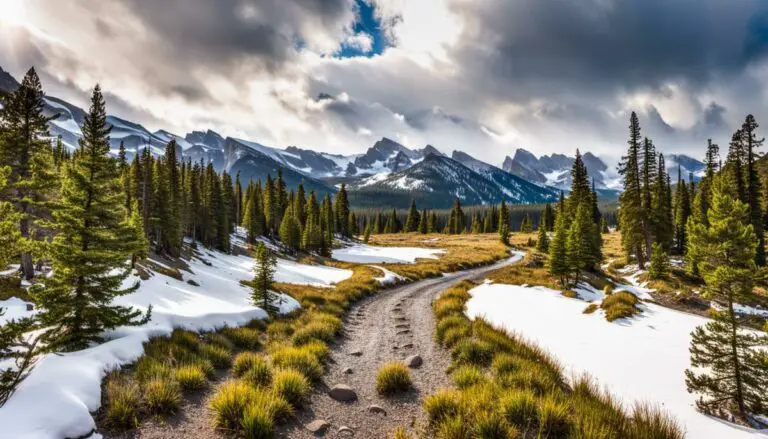
Safety and Preparation for Hiking in the Rocky Mountain National Park
Essential Documents and First Aid Necessities
Being fully prepared for your hiking trip in the Rocky Mountain National Park means having the correct documentation at all times. This includes relevant permits – crucial for overnight camping, and trail maps to guide you. Always have your identification on you, and it can be handy to have the park rangers’ emergency contact numbers saved.
Moreover, a fully stocked First Aid Kit is a hiking necessity. Items to include range from antiseptic wipes, adhesive bandages of several sizes, blister plasters, butterfly bandages, gauze pads, to a small roll of medical tape, tweezers, and safety pins. Include pain relievers and remember to bring your personal medications if necessary. Before you embark, ensure you notify someone of your hiking plans and your anticipated return time for safety.
Attire and Food
Dress strategically in layered clothing as weather in the Rockies can be unpredictable. Always have a waterproof layer to protect from potential rain, and bring warm clothing because temperatures can drop significantly. High-quality hiking shoes, ideally waterproof, provide traction and prevent injury.
Food and water are essential. Carry enough for the entire hike, plus a little extra. Consider packing high-energy foods such as nuts and energy bars. Always carry purification tablets or a water filter in case you need to refill from a natural water source.
Safety Measures and Tools
Follow marked trails to avoid getting lost. Have a compass and a map as a backup to your GPS device. A whistle is useful for alerting others in case of emergency.
Headlamps or flashlights with extra batteries are necessary for hiking during dawn, dusk, or night. Always prioritize safety over hiking speed or distance covered.
Emergency Procedures
Always have a clear plan of action in case of emergencies. In case of severe injury or illness, call 911 immediately. If you are lost, call the local park rangers or use a whistle to signal for help.
Knowing basic emergency survival techniques, such as how to build a fire or create a shelter, can be invaluable in extreme situations. Familiarize yourself with basic first aid procedures for common hiking injuries.
Wildlife Encounters
The Rocky Mountain National Park is home to a variety of wildlife. Bears, moose, and other large animals can pose a real threat. Carry bear spray and know how to use it. Avoid approaching or startling wildlife and keep a respectful distance. Educate yourself about the steps to take if you encounter a wildlife species.
Weather Considerations for Hiking
When planning your hike through the Rocky Mountains, it’s crucial to consider the rapid shifts in weather that can occur. It’s not uncommon for blue skies to swiftly give way to a snowstorm. Thus, checking the weather forecast before embarking on your hike is essential. Prepare yourself for the challenges that chilly temperatures and higher elevations can pose, including the risk of hypothermia and altitude sickness. In order to acclimate appropriately, take periodic breaks as needed.
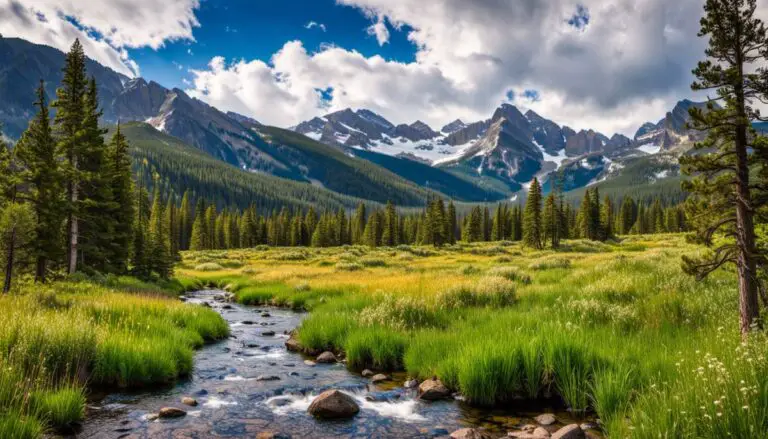
Flora and Fauna of Rocky Mountain National Park
Nature’s Bounty in Rocky Mountain National Park
As you hike through Rocky Mountain National Park, you’d be captivated not only by the awe-inspiring landscapes but also its rich biodiversity. The Park showcases a host of natural wonders including over 1,000 different plant varieties and 280 distinctive bird species. Additionally, you might even catch a glimpse of some larger mammals, such as elk, moose, and black bears that call this Park home.
Distinct Vegetation Zones
The Park’s flora can be segmented into five distinct zones: montane, subalpine, alpine, riparian, and wetland. The montane zone, occurring at lower elevations, is characterized by ponderosa pine forests and meadows filled with wildflowers in the summer. The subalpine zone is dominated by lodgepole pine forests and spruce-fir forests. The treeline signifies the start of the alpine zone, where the harsh climate allows for only the hardiest of plants, such as the alpine sunflower. Riparian and wetland zones are shaped by the presence of water and are excellent habitats for a diverse range of plant species.
Wildlife Encounters
If you’re lucky, a hiking excursion in the Park could allow you to spot some of its resident wildlife. Apart from the large mammals mentioned above, mule deer, coyotes, bighorn sheep, and even elusive creatures like mountain lions, bobcats, and lynxes also inhabit the Park.
Birdwatchers will particularly enjoy Rocky Mountain National Park as it is a nesting ground for a variety of bird species including the White-tailed Ptarmigan, the Western Tanager, and the Mountain Bluebird.
Aquatically-inclined wildlife such as Greenback Cutthroat Trout can be spotted in the park’s lakes and well-preserved stream habitats.
Hikers should be aware and respectful of wildlife and should never feed or attempt to touch any wild animal.
Ecological Significance
The Park sits within the Southern Rocky Mountain Biosphere Reserve, signaling its global ecological significance. This designation stresses the outstanding biodiversity that gives the Park its aesthetic and ecological-rich value and emboldens efforts to maintain and preserve this area.
Conservation Programs
The National Park Service has in place several conservation programs aimed at the protection and preservation of this precious ecosystem. These initiatives involve species monitoring, environmental education programs, wildlife management, and restoration projects.
For example, the Elk and Vegetation Management Plan involves monitoring elk populations and the impact of their grazing on the ecology. Other key programs include efforts to restore the natural fire regime, invasive species control, and preservation of the native Greenback Cutthroat Trout.
Embarking on a hike through Rocky Mountain National Park is a spellbinding journey filled with diverse wildlife and breathtaking scenery. As we traverse this awe-inspiring landscape, it’s vital that we take on the role of conscientious explorers, striving to appreciate and preserve these natural marvels for future generations.
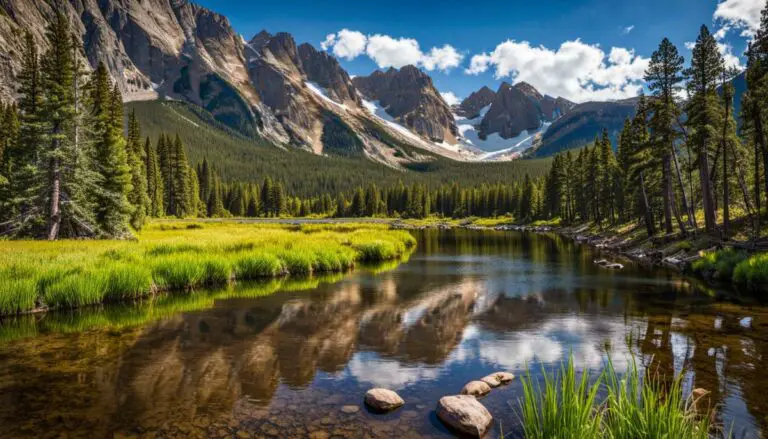
Seasonal Considerations for Hiking in Rocky Mountain National Park
Seasonal Aspects Impacting Your Rocky Mountain Adventures
Before you lace up your hiking boots and hit the trails of Rocky Mountain National Park, take a moment to consider the time of year. The shifting of the seasons brings significant changes to the trails, wildlife behavior, weather conditions, and visibility. These changes can have a profound impact on your hiking experience.
Spring: Thawing Out and Beckoning Wildlife
The arrival of Spring, from March through May, brings a period of change to Rocky Mountain National Park. Day-to-day temperatures can swing wildly, making layered clothing a smart investment for sudden chills. Higher trails may still be blanketed in snow and ice until late May or early June, necessitating the use of crampons or microspikes as a safety precaution. With many animals emerging from their winter slumber, wildlife activity increases; ensure you maintain a safe distance, particularly from juvenile animals and their mothers.
Summer: Peak Hiking but Watch the Skies
The summer months, June through August, are the peak of the hiking season. The park is fully accessible, and a rainbow of wildflowers carpets the mountain and meadow landscapes. However, this is also the busiest season. Early morning hikes are recommended to avoid crowds and find parking. With near-daily afternoon thunderstorms, aim to be off high-altitude trails before noon to avoid lightning risk. Also, observe fire safety rules as forest fires are a potential hazard in these dry months.
Autumn: Fall Foliage and Elks Rutting Season
Traditionally taking place from September to November, autumn brings cooler temperatures and stunning fall colors which make for amazing photogenic trails. It also marks the elk rutting season, a spectacle that draws numerous wildlife enthusiasts. Take note, trail closures may be implemented due to increased wildlife activity. Remember to pack warm clothing as temperatures can drop significantly during the nights.
Winter: Snowy Trails and Solitude
From December to February, winter transforms Rocky Mountain National Park into a snowy wonderland. Many higher elevation trails may be closed due to snow, but lower elevation trails are open to hikers and snowshoers. Be ready for dramatic temperature changes and pack accordingly with adequate insulation layers and gear. Winter hiking offers a surreal and peaceful experience and is perfect for those seeking solitude.
As an adventurer planning to hike in the Rocky Mountain National Park, it is important to respect the park’s natural beauty and stay on marked trails for safety. Familiarizing yourself with the Leave No Trace principles is vital and applying them throughout your hike can truly preserve the pristine environment of the park. Regularly updating yourself on weather forecasts and trail conditions will enable you to enjoy a safe and memorable hiking experience.
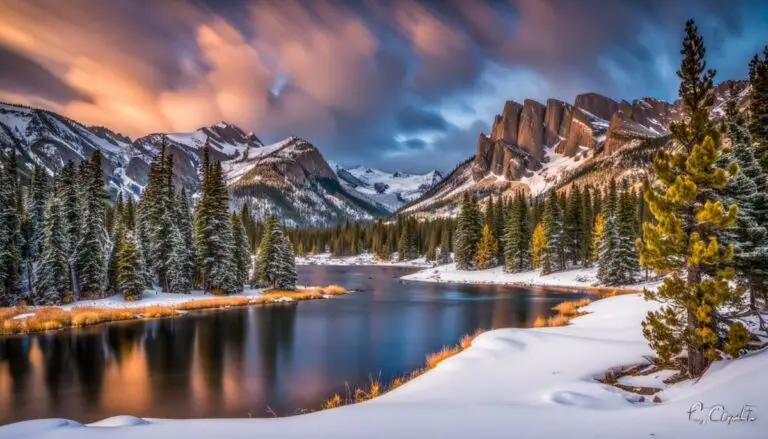
History and Cultural Significance of Rocky Mountain National Park
The Historical Legacy of Native American Tribes in Rocky Mountain National Park
Rocky Mountain National Park’s rich cultural heritage is deeply rooted in the history of Native American tribes like the Arapaho, Cheyenne, Ute, among others. These tribes have had a connection with the area for over 11,000 years, such a deep connection that their ancestral footprints are embedded within the myriad of archaeological sites scattered throughout the park. Sites such as Game Drive tell tales of their hunting techniques used on large mammals during the late prehistoric period, serving as a prominent reminder of their historic presence.
Establishment of Rocky Mountain National Park
Many American settlers and explorers flooded into what is now Rocky Mountain National Park in the 19th century, especially after the 1859 Colorado Gold Rush. However, it wasn’t until 1915 that American industrialist John D. Rockefeller financed the establishment of the National Parks Conservation Association, leading to President Woodrow Wilson signing the Rocky Mountain National Park into law. This act brought the park into the National Park System, which aimed to conserve and protect unique environments for future generations.
Development of Rocky Mountain National Park
The development of the park as a recreational area took shape in the 1930s under President Franklin D. Roosevelt’s New Deal programs. The Civilian Conservation Corps (CCC) established camps in the area and worked on infrastructure projects such as trail construction and maintenance, bridge and building construction, and erosion control. The CCC’s efforts are still visible in the park today, particularly in relation to some of its major hiking trails.
Hiking in Rocky Mountain National Park
The park now boasts over 359 miles of hiking trails offering outdoor enthusiasts a chance to explore the stunning beauty of the Rockies. These trails range from flat and relaxing walks around crystal clear lakes to adventurous hikes to summit peaks over 12,000 feet high. Each trail provides unmatched opportunities to witness wildlife in their natural habitat and enjoy the breathtaking scenic beauty the park offers.
Rocky Mountain National Park’s Contributions to Outdoor Recreation and Conservation
Rocky Mountain National Park has contributed enormously to the culture of outdoor recreation. The park not only provides a vast wilderness for adventurers to explore but also fosters environmental consciousness and respect for nature’s raw beauty. It has become a provider of an array of eco-friendly activities, including hiking, nature photography, bird watching, and camping, drawing visitors from all over the world each year.
Moreover, the park plays a crucial role in conservation. It’s home to hundreds of species of flora and fauna, some of which are endangered. The park’s management takes such a preservation-friendly approach to encourage regrowth and repopulation of these species.
Indigenous Cultural Education in Rocky Mountain National Park
Today, the park makes efforts to educate visitors about the park’s rich indigenous heritage. Visitors can learn about these indigenous communities through educational programs offered by the park, including guided hikes focusing on historical and cultural awareness. Efforts to share and preserve the history and culture of the Native American tribes associated with the Rocky Mountain National Park help visitors gain a deeper understanding and appreciation of the park’s significance.
Embracing the magic of Rocky Mountain National Park means more than simply setting foot on its trails; it’s about understanding the intricate ecosystem, respecting the wildlife inhabitants, and embracing the cultural and historical essence of this cherished place. As the seasons shift, so do the opportunities for discovery and adventure in the park, bringing ever-changing backdrops and experiences. With careful preparation and mindful consideration of our advice, the serenity, beauty, and awe-inspiring grandeur of the Rockies can be enjoyed in their fullest expression. As you venture into the wild heart of the park, carry with you the spirit of exploration and reverence that has defined this national treasure for generations.
Proud owner of https://travelyouman.com/
